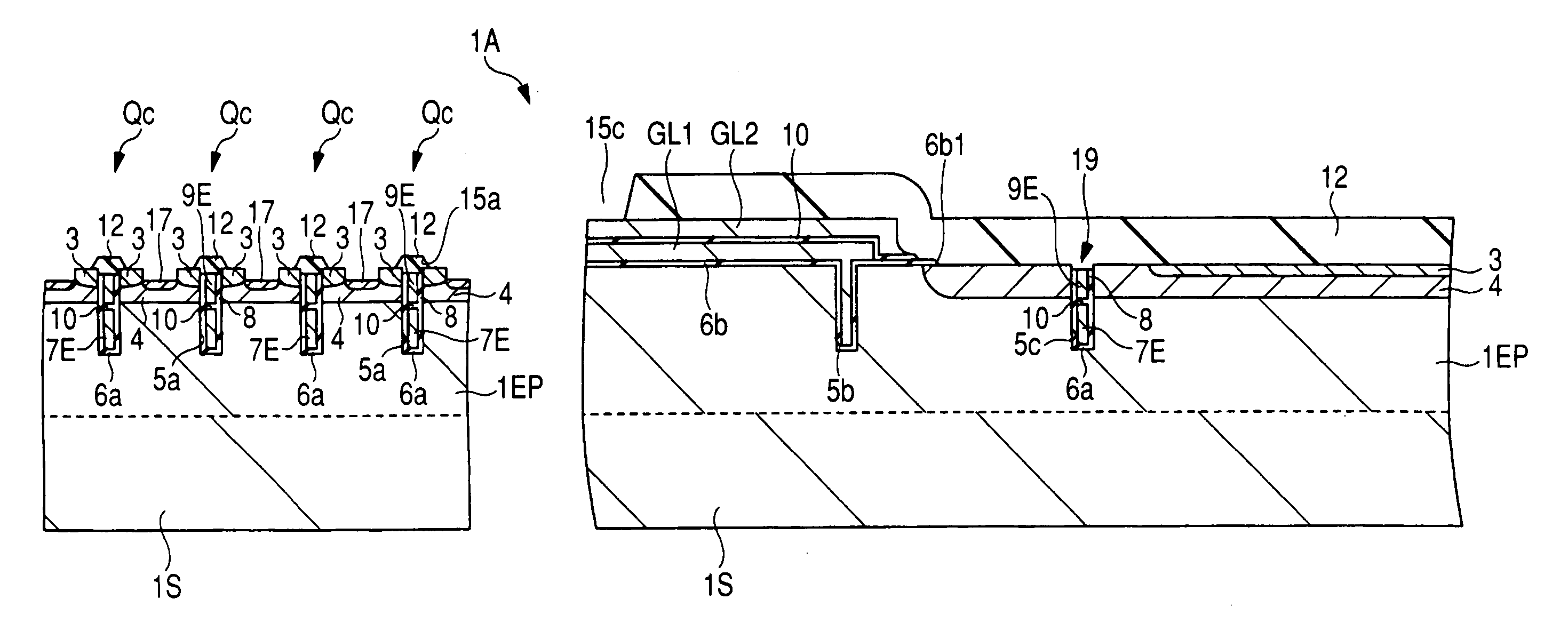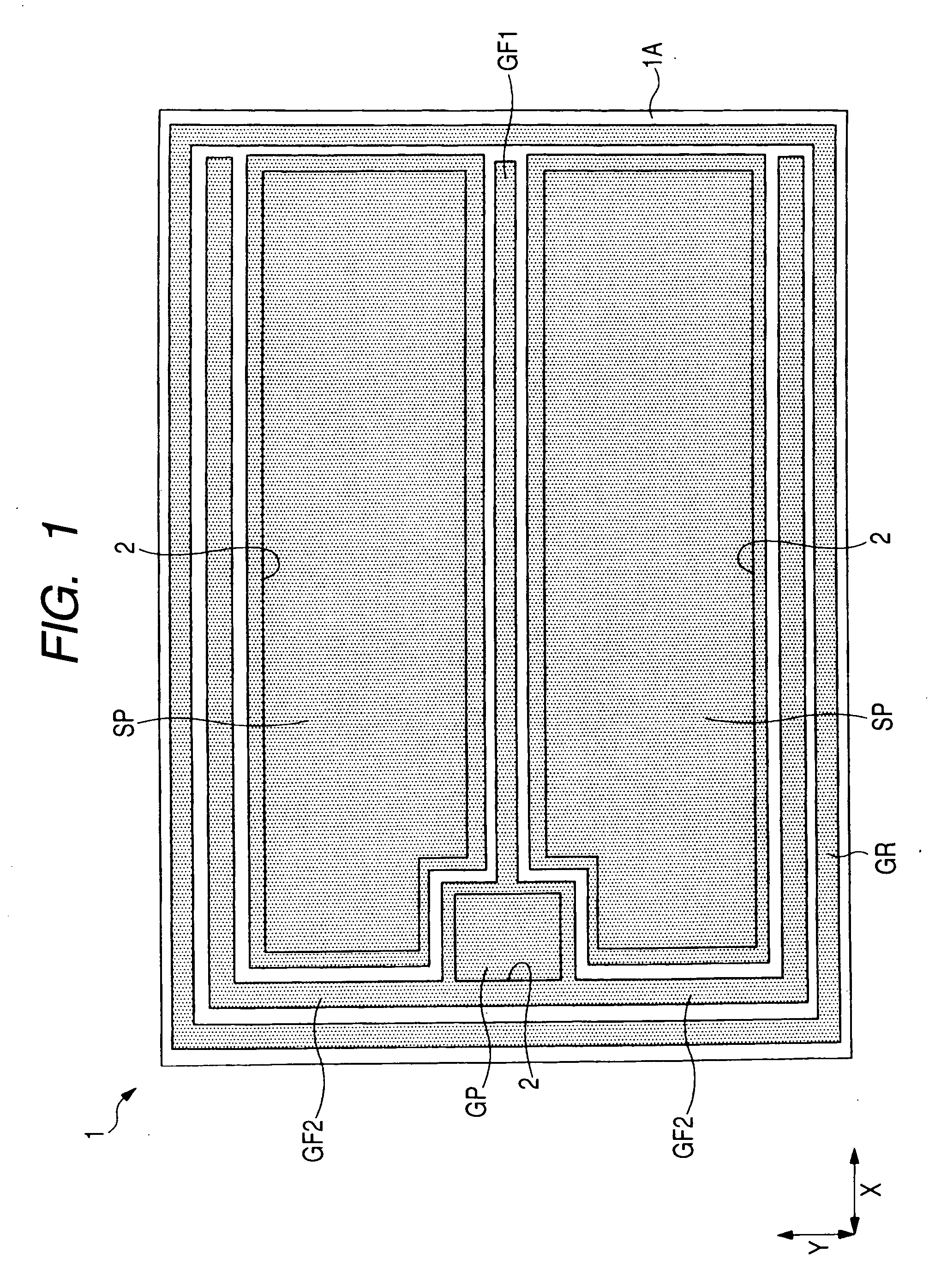Semiconductor device and manufacturing method of the same
a semiconductor device and manufacturing method technology, applied in the field of semiconductor devices, can solve the problems of reducing the cell pitch of power mos-fets and reducing their on-resistance, and achieve the effect of suppressing or preventing the operation of parasitic elements reducing the on-resistance of the semiconductor device, and reducing the resistance of the semiconductor devi
- Summary
- Abstract
- Description
- Claims
- Application Information
AI Technical Summary
Benefits of technology
Problems solved by technology
Method used
Image
Examples
first embodiment
[0055]FIG. 1 and FIG. 2 are plan views of a semiconductor chip that constitutes a semiconductor device in a first embodiment; FIG. 3 is an enlarged plan view of area RA in the semiconductor chip in FIG. 2; FIG. 4 is a sectional view taken along line X1-X1 of FIG. 3; FIG. 5 is an enlarged sectional view of a substantial part of the semiconductor chip in FIG. 4; FIG. 6 is an enlarged plan view of a substantial part of the semiconductor chip in FIG. 3; and FIG. 7 is a sectional view taken along line Y1-Y1 of FIG. 3. Code Y indicates a first direction, and code X indicates a second direction orthogonal to the first direction. The first direction Y is equivalent to the direction of the short sides of the semiconductor chip. It is also equivalent to the direction of the length (extension) of the gate electrode of a power MIS-FET (Metal Insulator Semiconductor-Field Effect Transistor) The second direction X is equivalent to the direction of the length of the semiconductor chip, and is also...
second embodiment
[0093] Description will be given to the above-mentioned cutoff portion 19 in relation to a second embodiment. The configuration of the chip 1 is the same as described with respect to the first embodiment with reference to FIG. 1 to FIG. 7. In the following description of the second embodiment, the same members as described with respect to the first embodiment will be marked with the same numerals or codes.
[0094]FIG. 15 is a sectional view taken along line Y2-Y2 of FIG. 3. The second embodiment is provided with a cutoff portion 19. It is positioned between an end of a semiconductor region 3 for source on the periphery of a group of the multiple cells Qc of the power MIS-FET Q (position P4) and an end 6b1 of an insulating layer 6b for isolation provided outside of the end (position P4) of the semiconductor region 3 for source. The cutoff portions 19 are provided between adjoining gate electrodes 9E so that they are extended in the second direction X and intersect the gate electrodes ...
third embodiment
[0100] With respect to a third embodiment, description will be given to an example of the manufacturing method for the power MIS-FET Q, described in relation to the first and second embodiments, with reference to FIG. 20 to FIG. 36. In FIG. 20 to FIG. 36, the left part shows the element formation region (region where a group of the cells Qc of the power MIS-FET Q are to be formed), and the right part shows the peripheral region (regions including the isolation regions).
[0101] First, a substrate 1A (a planar and circular semiconductor wafer in this stage), illustrated in FIG. 20, is prepared. This substrate is obtained by growing the epitaxial layer 1EP, composed of a high-resistance n-type silicon (Si) single crystal, over the substrate portion 1S composed of a low-resistance n+-type silicon (Si) single crystal. Subsequently, an insulating layer 30 composed of, for example, silicon oxide is formed over the main surface of the substrate 1A (the upper face of the epitaxial layer 1EP)...
PUM
 Login to View More
Login to View More Abstract
Description
Claims
Application Information
 Login to View More
Login to View More - R&D
- Intellectual Property
- Life Sciences
- Materials
- Tech Scout
- Unparalleled Data Quality
- Higher Quality Content
- 60% Fewer Hallucinations
Browse by: Latest US Patents, China's latest patents, Technical Efficacy Thesaurus, Application Domain, Technology Topic, Popular Technical Reports.
© 2025 PatSnap. All rights reserved.Legal|Privacy policy|Modern Slavery Act Transparency Statement|Sitemap|About US| Contact US: help@patsnap.com



